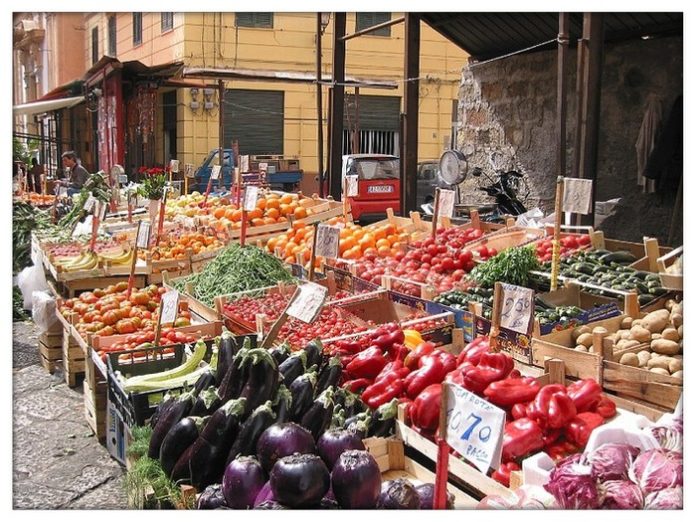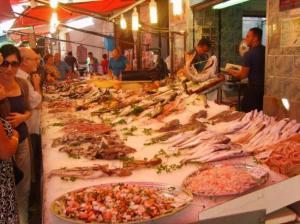 It’s a heart beating with memories, emotions, the centre of a city whose streets and ravines hidden to the eyes of the passer-bys are steeped in history. Walking across the “Capo” means going through the artery of a market whose roots dip into the substratum of Palermo made of “abbanniaturi” (sellers of fruit, vegetables, meat and various stuff), of stalls “cunzate” (which literally means seasoned, i.e. made ready), “riffaturi” (sellers of raffle tickets), of “fimmini massari” (women devoted to housework – housewives), “picciriddi ri nutricari” (babies to bring up) and dogs “lagnusi” (moaning, sluggard) which idle about waiting for the leftovers from the shops. It’s a street rich of colours, life, style all referring to a past that has never been betrayed, while our steps lead us towards a labyrinth of emotions which start from the Courthouse and reach the Cathedral.
It’s a heart beating with memories, emotions, the centre of a city whose streets and ravines hidden to the eyes of the passer-bys are steeped in history. Walking across the “Capo” means going through the artery of a market whose roots dip into the substratum of Palermo made of “abbanniaturi” (sellers of fruit, vegetables, meat and various stuff), of stalls “cunzate” (which literally means seasoned, i.e. made ready), “riffaturi” (sellers of raffle tickets), of “fimmini massari” (women devoted to housework – housewives), “picciriddi ri nutricari” (babies to bring up) and dogs “lagnusi” (moaning, sluggard) which idle about waiting for the leftovers from the shops. It’s a street rich of colours, life, style all referring to a past that has never been betrayed, while our steps lead us towards a labyrinth of emotions which start from the Courthouse and reach the Cathedral.
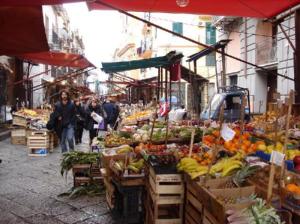 The entrance to the “Capo” is really suggestive, as it is contained in one of the most ancient doors of the city, Porta Carini: built in 1310, it was a simple arch of stone which, through the fields, opened the way from the city towards the town of Carini: this explains its name. The door was entirely rebuilt in 1782, it was bought by the nuns of the Conception and used as viewpoint. Today it is a door which has retired, it doesn’t have any more its original function and has become a stately matron greeting the tourists, the customers of the market, making a fine show and allowing everyone to take photographs. The journey from via Porta Carini to via Beati Paoli is full of reminders, the thought goes to the passages written by Luigi Natoli in his novel outlining the feature of a mysterious sect of hooded men that at the end of XVII century, according to stories which have become legendary, used to meet in a cavern in the neighbourhood. The aim of the sect was to punish the wrong, through evil, with the will to make good prevail, to demolish abuses and injustice, to seek vengeance for the helpless.
The entrance to the “Capo” is really suggestive, as it is contained in one of the most ancient doors of the city, Porta Carini: built in 1310, it was a simple arch of stone which, through the fields, opened the way from the city towards the town of Carini: this explains its name. The door was entirely rebuilt in 1782, it was bought by the nuns of the Conception and used as viewpoint. Today it is a door which has retired, it doesn’t have any more its original function and has become a stately matron greeting the tourists, the customers of the market, making a fine show and allowing everyone to take photographs. The journey from via Porta Carini to via Beati Paoli is full of reminders, the thought goes to the passages written by Luigi Natoli in his novel outlining the feature of a mysterious sect of hooded men that at the end of XVII century, according to stories which have become legendary, used to meet in a cavern in the neighbourhood. The aim of the sect was to punish the wrong, through evil, with the will to make good prevail, to demolish abuses and injustice, to seek vengeance for the helpless.
The Market lives inside a popular quarter, called of “Seralcadio”, know today precisely as “Capo”, and has always been the market of the people since its foundation in the age of the Muslim domination. It slightly resembles a souk, an oriental bazaar, a feeling which is confirmed more than ever once standing before the “Antica Drogheria di Dainotti”. In fifty years this historical grocery store has seen many many visitors, local customers and tourists, all of them buying the most refined spices, since the grocery stocks up on them from all over the World.
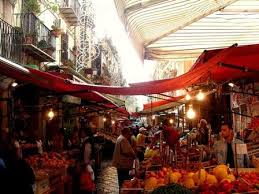 Antonio Orlando, the nephew of the first owner, proudly shows Pimento, Marjoram, Cumin, Coriander, Capers and other various spices, a stock which has nothing to envy from the Egyptian nor the Moroccan sellers. Perfumes and promises of flavours mix in a game of cheerful rituals: the merchandise is “abbanniata” (shouted), weighted, smelled and then bought. All around the Grocery, quarters of beef hanging, bakeries, vegetables exposed to the sun and to adventure, and all this tells of those ancient forms of barter which lead to today’s sale, in a context which is still the same. The street goes on with bottlenecks and new things to look at, “putìe” (shops) and “putiari” (dealers) tiding up their merchandise, and one would never imagine to find a colossus of pure magnificence in the middle of all this. Immersed in this colourful and grotesque context, the church of the Immacolata Concezione rises above the swaying crowd. A flower which blossoms to the night, in a flourishing of stucco works and of pure, beautiful baroque.
Antonio Orlando, the nephew of the first owner, proudly shows Pimento, Marjoram, Cumin, Coriander, Capers and other various spices, a stock which has nothing to envy from the Egyptian nor the Moroccan sellers. Perfumes and promises of flavours mix in a game of cheerful rituals: the merchandise is “abbanniata” (shouted), weighted, smelled and then bought. All around the Grocery, quarters of beef hanging, bakeries, vegetables exposed to the sun and to adventure, and all this tells of those ancient forms of barter which lead to today’s sale, in a context which is still the same. The street goes on with bottlenecks and new things to look at, “putìe” (shops) and “putiari” (dealers) tiding up their merchandise, and one would never imagine to find a colossus of pure magnificence in the middle of all this. Immersed in this colourful and grotesque context, the church of the Immacolata Concezione rises above the swaying crowd. A flower which blossoms to the night, in a flourishing of stucco works and of pure, beautiful baroque.
 Polychrome marbles tell of the typical taste of XVII century of a Palermo under the Spanish domination. Towards the end of XVI century the nuns of the Benedictine order decided, under the helping hand of Jesuit Giacomo Sardo, to move from the Cathedral to the popular quarter of Seralcadio, founding the convent in the following years. The sacred room originally was much smaller, the first decoration are believed to have been only paintings, but today one can admire a church literally covered with ornaments, from the ceiling to the floor. Each centimetre is made of marbles, angels announcing the Gospel and putti dancing motionless in a blaze of opulence. The nave has been defined as “garden of stone” and the whole structure is a pearl contained in a shell, the market which deserves to be safeguarded. The church of the “Concezione al Capo” is the sacred mixing with profane in an endless, balanced and careful game.
Polychrome marbles tell of the typical taste of XVII century of a Palermo under the Spanish domination. Towards the end of XVI century the nuns of the Benedictine order decided, under the helping hand of Jesuit Giacomo Sardo, to move from the Cathedral to the popular quarter of Seralcadio, founding the convent in the following years. The sacred room originally was much smaller, the first decoration are believed to have been only paintings, but today one can admire a church literally covered with ornaments, from the ceiling to the floor. Each centimetre is made of marbles, angels announcing the Gospel and putti dancing motionless in a blaze of opulence. The nave has been defined as “garden of stone” and the whole structure is a pearl contained in a shell, the market which deserves to be safeguarded. The church of the “Concezione al Capo” is the sacred mixing with profane in an endless, balanced and careful game. 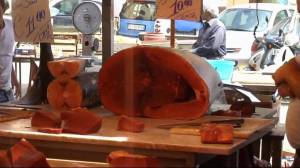 Getting out of the sacred room and finding oneself in the street, to abandon the devoted silence and give again space to the colourful hubbub, leaves one bewildered for the fraction of time the greengrocer needs to attract the attention on his merchandise.
Getting out of the sacred room and finding oneself in the street, to abandon the devoted silence and give again space to the colourful hubbub, leaves one bewildered for the fraction of time the greengrocer needs to attract the attention on his merchandise.
And while one is intent on choosing between asparagus (“sparaci” on the price sign) and medlar, the great humanity of Capo reveals: a woman crosses the street, shaking on thin legs, with an uncertain landingplace. She’s pregnant and she carries an infant clinging to her neck. She looks tired, hungry and she has got only a coin in her hand. She goes to the greengrocer and asks “how much for a lettuce?”, then her glance is attracted by the big aubergines, which look nice. So she plucks up courage and opens her hand, she shows the coin and asks “can you give me one?”. He doesn’t stagger, while dignity wavers, opens a bag and starts filling it up. He puts vegetables and stops that hunger, hands the shopping towards those two Euros and that woman, smiling with her small blackened teeth, says “and what about the change?”. He turns back to his customers while telling her “the change is in the bag”. If these scenes of hunger, misery and rediscovered humanity still happen in 2011, this makes one think that everything turns, fortune and cards, but sometimes it’s a bad turn.
Antonio Fiasconaro

